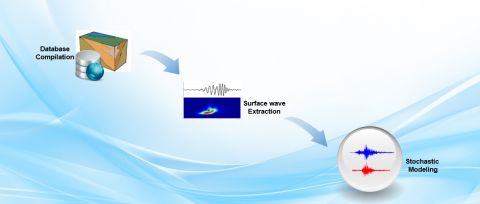The scope of this work package is the development of a phenomenological model of ground motion that takes into account the amplification and lengthening induced by basin generated surface waves. The model will be physically constrained as it will be based on analysis and synthesis of real recorded data.
Compilation, analysis and parametrization of a database of recordings on sedimentary basins
This task comprises the identification, investigation and characterization of sedimentary basins around the world (Europe, United States, Taiwan, Japan and New Zealand) that have been excited by recent strong earthquakes and the recordings of which are available on publicly accessible databases. Several of those basins have been excited by incident seismic energy coming from different azimuthal directions and different epicentral distances. This will allow us to investigate to what extent the geometric structure of the basin edge (steepest-dipping vs. smoothly dipping edge) diffracting the incoming energy is affecting the generation of the surface waves.
Identification and extraction of surface waves
In previous studies, analysis of recorded data provided the means to establish phenomenological models taking into account the effects of surface. This demonstrates the crucial importance of detection and extraction of surface waves from real ground motion time histories. Recently we have developed a robust and effective identification and extraction technique (Meza-Fajardo et al., 2015) to facilitate the study and modeling of surface waves. This time-frequency technique allows one to identify the direction of propagation of surface waves that are present in the signal, as well as to differentiate between prograde and retrograde Rayleigh waves.
Stochastic modeling of surface waves
Compilation of a sufficiently extensive and diverse database of strong motion data recorded on sedimentary basins, allows the development of a stochastic model which, on one hand, may be used for the synthesis of realistic realizations of strong motions that contain surface waves and, on the other hand may be used for the analytical description of the evolutionary spectral content of seismic ground motions that contain surface waves.

WP leader: Kristel Meza-Fajardo (BRGM)


